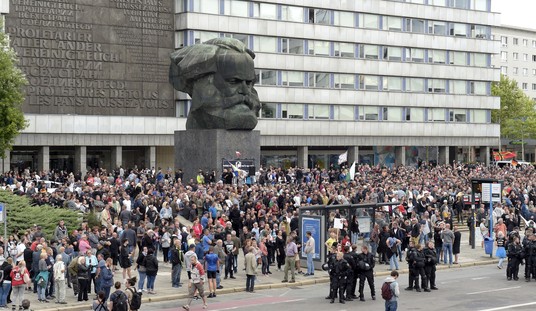Mr. Romney, here is the low point of your participation in this week’s foreign policy debate:
SCHIEFFER: Well, Governor, let me just ask you. If you declare them a currency manipulator on day one, some people are — say you’re just going to start a trade war with China on day one. Is that — isn’t there a risk that that could happen?
ROMNEY: Well, they sell us about this much stuff every year, and we sell them about this much stuff every year. So it’s pretty clear who doesn’t want a trade war. And there’s one going on right now, which we don’t know about it. It’s a silent one. And they’re winning.
We have enormous trade imbalance with China, and it’s worse this year than last year, and it’s worse last year than the year before. And so we have to understand that we can’t just surrender and lose jobs year in and year out. We have to say to our friend in China, look, you guys are playing aggressively. We understand it. But this can’t keep on going. You can’t keep on holding down the value of your currency…”
Mr. Romney, it’s not really your fault. You attended Harvard Business School in the early 1970s. This was a high water mark for Keynesian economics which ruled, virtually not only without challenge, but virtually without even the knowledge that there was any alternative.
Later, the rise of stagflation would open a national debate between Keynesianism and supply-side thinking, but by then you were no longer studying economics and were embroiled in the day-to-day challenges of business management. You missed Robert Mundell and Art Laffer’s challenge to the academic status quo. You missed Milton Friedman’s refutation of the socialist model, as well as Hayek and Von Mises’ case for the denationalization of money. In other words, you missed almost everything a future president would need in order to understand the way the world works when it comes to currency markets. While Reagan’s lax attitude towards schooling and his C+ grade average landed him at Eureka College, not nearly prestigious enough for the Keynesians to grab control of, your intelligence and drive got you into the top business school in the world. Reagan got the better end of that deal.
Recommended
So, if you’re going to avoid speaking nonsense about the dollar, and even worse, hastening its demise, you’re going to need to go back to the beginning, to first principles.
Here they are:
What is a dollar worth compared to a unit of another currency? How do you even begin to answer a question like that? Bonds are valued based on the interest payments they offer. Stocks are valued based on their earnings. But what about currencies, how can you place a valuation on them? And if you can’t place a valuation on them, how can you possibly make investment decisions in a global market which implicitly includes a currency component?
A colleague of mine, who works for one of the largest financial service companies in the world, recently told me that his company attempted to analyze foreign exchange market data and could find no useful pattern, just apparent randomness. I’m not surprised, others have tried to create complex econometric models, but the financial world does not seem to have cracked the code on exchange rates, and the more complex their mathematical models, the farther they seem to be from an answer. However, I tend to believe that the more complex the system, the more need there is for a simple set of principles from which to reason.
The Law of One Price: This principle is the beginning of currency valuation and it goes back over half a millennium. This law states that if you have the same good in two different locations, and their prices once adjusted for currency exchange rates are different, the market will tend to pull the prices back towards parity. For example, if a chocolate bar costs two dollars, and the exchange rate between dollars and pounds is two to one, then the same chocolate bar will tend towards a price of one pound. If this parity does not exist, for example, if chocolate bars are more expensive in pound terms then they are in dollar terms, people will stop buying chocolate bars with pounds and start buying them with dollars until the difference is arbitraged away. In modern economics this is concept is called ‘purchasing power parity’, and is used extensively in international economics.
But it has some important exceptions: Even in the late middle ages, the theologians-cum-proto-economists realized that the arbitrage effect is net of transportation costs. In other words, the price difference between a chocolate bar in England and an identical bar in the United States may not be completely arbitraged away by the importation of U.S. chocolate bars because there is still the matter of transportation costs. It is the cost to consumers, i.e. the cost after transportation, which is the parity price, not the cost of the commodity in its native land.
Medieval thinkers were also living before the rise of the nation-state and therefore before economic nationalism. They did not live in a world, like the modern world, during which protectionism in the form of trade bans were common and effective. National borders were far more porous; national loyalties, far weaker.
Since the rise of the modern nation-state, classical economists have had to reason further from the Law of One Price, pointing out that the Law of One Price is a law of market-based economies and that the law becomes distorted as the market become distorted by forcible interruptions in transnational exchanges. Trade bans of various types become an additional wedge between buyer and foreign seller interfering with the arbitrage process. Likewise protective tariffs. In the latter case tariffs become an additional difference between the two prices when in parity. Price parity is net of transportation costs and of import taxes both. In other words, the Law of One Price refers to the profit margins, or the excess of price over cost, and not just the price. That is, the profit margins between selling in those different locations will tend to be equalized. In the case of trade bans the price differential has to account for black market risk such as the risk of imprisonment and the cost of bribes. The more protectionist the world, the more exceptions to the parity rule there are.
That’s the basic picture. Study up on that. Throw out all of the 1960s and early 1970s de rigueur stuff you were force-fed back at Harvard: Samuelson, Okun gaps, interest rate parity, etc. Then next week we’ll be ready to go on to the next step and show why China’s exchange rate is not a threat to us and why nationalist saber rattling is worse than useless.
____________________________________________________________
Mr. Bowyer is the author of "The Free Market Capitalists Survival Guide," published by HarperCollins, and a columnist for Forbes.com.

























Join the conversation as a VIP Member